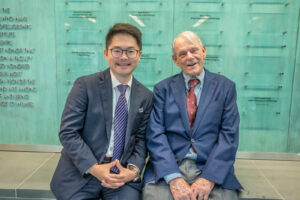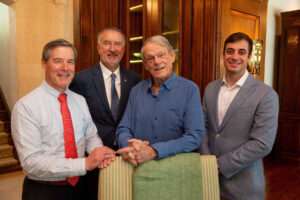Johns Hopkins UniversityEst. 1876
America’s First Research University
James Gills Jr. is dedicated to reaching the pinnacle of excellence — as an ophthalmologist, as a businessman, as a spiritual man, even as an Ironman. In ophthalmology, he is renowned for building a practice, St. Luke’s Cataract and Laser Institute in Florida, that performs cataract surgeries daily and hosts ophthalmologists and trainees from all over the world to teach them how he runs his remarkable practice. In the business world, he is admired for the foresight that has allowed him to invest early in companies that have become household names. In his spiritual life, he has authored more than 40 books focused on faith-based journeys and insights, including his own. And, always motivated to challenge himself further, he has run more than 46 marathons and participated in multiple Ironman Triathlons. Indeed, at one time, he was the Ironman — owning the actual Ironman brand and World Triathlon Corporation.
Before all these accomplishments, however, Gills was a newlywed who arrived in Baltimore in 1962 with his wife, Heather, to begin his residency at the Wilmer Eye Institute. “Everything was new!” says Heather. “We were newlyweds of one week. It was a new residency and a new job for me as a high school biology teacher. But we were not daunted one bit.”

Heather had never lived outside of Georgia and, as she embarked on her career as one of the first teachers at the newly built Overlea High School, Gills excelled in his training. “We had a three-year honeymoon and loved Wilmer, our new friends and being at the best eye hospital in the world,” says Heather.
At Wilmer, Gills became especially close to his mentor Frank B. Walsh, MD, a father of the neuro-ophthalmology field, and enjoyed the hard work of becoming an ophthalmologist. “Wilmer is a great place if you want to work,” says Gills. “People don’t go slow, get a lot done but are thorough and honest about what they do.”
In the decades since his residency, as Gills’ successes have grown and multiplied, so has the couple’s generosity. In one of his many books, True Giving, he explains his philosophy on philanthropy: “It is imperative to be a good steward of God’s monetary gifts. God is Love, and the DNA of Love is giving.”
Or, as he puts it when speaking face to face, “If you don’t do anything for others, you’ve lived a useless life.”
This year, the Gills have chosen to give a transformational gift of $10 million to a place that transformed them both — Wilmer — by endowing the James P. Gills Jr., M.D., and Heather Gills Artificial Intelligence Innovation Center. Part of the gift to fund the AI center established the James P. Gills, Jr., M.D., and Heather Gills Rising Professorship of Artificial Intelligence in Ophthalmology. This inaugural professorship is held by T. Y. Alvin Liu, Med ’16 (MD), who will also serve as the inaugural director of the center.
“The mission is to be the premier academia-based center for artificial intelligence in ophthalmology,” Liu says. “We are at the ground level of this AI revolution, and with the Gills family’s generous donation, our future is bright.”

Gills became intrigued by the possibilities of artificial intelligence about a decade ago and decided to invest in NVIDIA — at the time known primarily as a video game company that had invented the graphics processing unit. That technology has since become the bedrock for the immense computing power needed for deep learning, a specific branch of artificial intelligence. “Business in this country will be augmented more greatly by AI than anything else,” says Gills. He believes AI will transform medicine as well but will “take a while … because there’s so much education that needs to occur about AI and how to use it.”
Gills considered how he could speed up research and adoption of AI in medicine. “He called me one day and said he thought that Wilmer was obviously the best place to have a program focused on exploring the use of artificial intelligence in ophthalmology,” says Wilmer Director Peter McDonnell, Med ’82 (MD), William Holland Wilmer Professor of Ophthalmology. “I had to agree with him, because after his call, I wrote to my colleagues on the faculty and asked them to send me their published articles about AI in scientific journals — and I received almost 100 papers.”
Combining the efforts of these faculty members under a central entity, McDonnell hypothesized, would allow Wilmer to supercharge their research projects by creating a hub for the exchange of ideas and information. The center could also become a source for all faculty members interested in using insights gleaned from AI to better care for patients, whether the faculty members were engaged in AI research or not. In addition, Wilmer could establish core resources — resources too expensive for a single researcher to set up — that could be leveraged by a steady stream of faculty members. And undergirding the enterprise would be the Hopkins ecosystem, which includes collaborators at the Whiting School of Engineering and the Johns Hopkins University Applied Physics Laboratory.
With the new innovation center, “We’re not just a group of eye doctors sitting on an island trying to figure it all out by ourselves,” says McDonnell.
Once the Gills family was presented with the idea of the innovation center, they gladly agreed to support its creation. “People at Wilmer are reasonable, responsible, accountable,” says Gills. “The center will continue to accomplish what has already started.”
The Gills’ transformational gift adds to the newly endowed James P. Gills, Jr. and Heather Gills Rising Professorship of Ophthalmology, held by Michael Sulewski, MD, and the existing professorships endowed by the Gills: the Frank B. Walsh Professorship, held by Amanda Henderson, MD, and the James P. Gills Professorship, held by Neil Bressler, Med ’82 (MD), as well as to a generous gift to Wilmer’s Robert H. and Clarice Smith Building Fund, bringing their giving to Wilmer to more than $20 million.
An earlier version of this story was published in Wilmer – Annual Report 2024.
Interested in supporting faculty and research at the Wilmer Eye Institute?
Topics: Faculty and Staff, Friends of Johns Hopkins Medicine, Johns Hopkins Medicine, Wilmer Eye Institute, Fuel Discovery